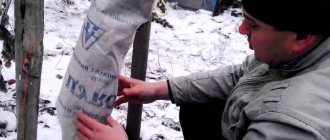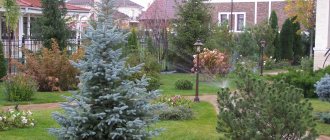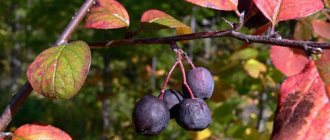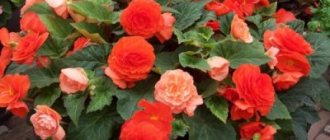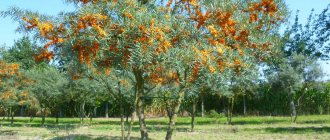Heliotrope flower: description of popular plant species and options for use in garden design
Semi-shrubs and herbaceous perennial plants do not require special care. The decorative crop has obovate, alternately arranged foliage of dark green color. Leaves with pubescence, wavy or wrinkled type, are located on fairly short petioles.
The flowers are small, fragrant, purple or dark blue in color, collected in dense corymbose inflorescences. In indoor floriculture, heliotropes can grow for several years, but in garden culture they are grown as a flowering, highly decorative annual. After flowering, fruits full of seeds are formed. Hybrid heliotrope is especially popular.
G. thyroid or thyroid
The tallest decorative species. The height of an adult plant reaches 120 cm. The above-ground part is represented by well-shaped stems and long, lanceolate, boat-shaped leaves. The outer part of the leaf blade has a slightly darker color. The flowering is beautiful and long-lasting, with blue or blue flowers collected in inflorescences up to 8-10 cm long. The culture is widely used as a background for creating multi-tiered flower beds, and is also suitable for group and single plantings.
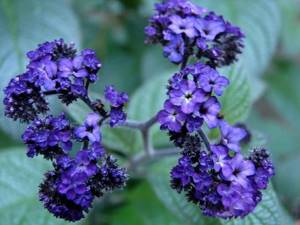
G. peruvian
Peruvian or Tree-like is one of the most common species in culture , and is a spreading bush with a height of the above-ground part of up to 40-60 cm. Fragrant and beautiful flowers of dark purple or rich bright blue color are collected in relatively large inflorescences that bloom before frost. The most popular hybrid forms include the “Marin” series. It is often used in group flower arrangements and single plantings when decorating the landscape of a personal garden.
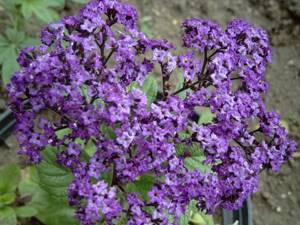
G. Kurasavsky
The species is a spreading, rather tall shrub. The diameter of the above-ground part is often 110-120 cm, with an average height of no more than 60-100 cm. The flowers are pale bluish-white, collected in inflorescences with a strong and long peduncle. The plant combines well with conifers and decorative deciduous perennials.
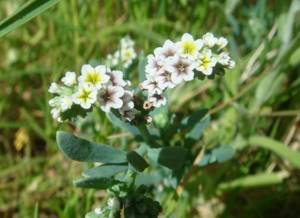
G. stem-encompassing
The shortest species, not particularly popular among amateur gardeners. The ornamental plant is distinguished by long lanceolate leaves with characteristic wavy edges and attractive purple flowers. In landscaping it is used as a carpet plant and planted to decorate borders and flower beds. Serves as an excellent complement to salvia, tuberous begonia and garden petunia.
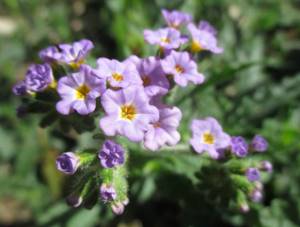
G. European
The perennial species “European” is characterized by a bush-like form with a height of the above-ground part of up to 35-40 cm. The foliage is greenish-yellow in color. The flowers are distinguished by original curls and a white corolla. They are located in the axils of the upper leaves. During the active flowering phase, the entire plant is covered with lush and dense inflorescences.
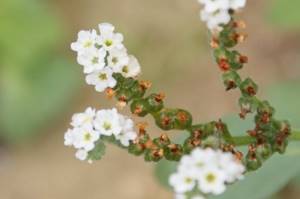
Heliotrope propagation
Those gardeners who want to decorate their plot with several beautiful heliotrope bushes should try to propagate the mother plant. This can be done in two ways:
- Heliotrope cuttings
. To do this, you need to choose the most beautiful bush in the summer. In the fall, it must be dug up from the flowerbed and, replanted in a pot, left to overwinter in the house or in an insulated greenhouse. In February-March, young strong cuttings should be cut from such a plant and their cuts should be treated with Kornevin. Plant in a container with soil and cover with film. After rooting (after about 20 days), the cuttings are transplanted into separate containers. Young plants can be planted outside when warm days arrive. - Propagation by seeds
. Seeds collected independently often turn out to be ungerminating, since in many areas they do not have time to ripen due to the early onset of cold weather. It is better to purchase seed material at a flower shop, and sow it as described above.
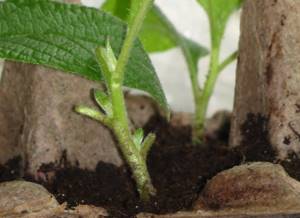

The best plant varieties
Despite the very large number of natural species, varieties belonging to the Peruvian or tree species (H. peruvianum, arborescens) have become widespread in culture. Such varieties are characterized by relative unpretentiousness, very abundant and fragrant flowering.
In flower beds, the crop can be very successfully combined with coreopsis and different types of begonias, rudbeckias, as well as mixtures of coleus. Among other things, a very effective flower combination can be obtained by planting different varieties of heliotrope in combination with petunia or cineraria.
How to sow heliotrope seeds (video)
Heliotrope “Sea Breeze”
The “Sea Breeze” variety is a compact ornamental plant with a height of the above-ground part of up to 40-45 cm, with bright fragrant inflorescences. The flowers are small in size, dark blue or dark purple in color, collected in corymbose inflorescences. Flowering is abundant and long lasting. The foliage is dark green with a purple tint. The leaves have a very characteristic obovate shape for the species.
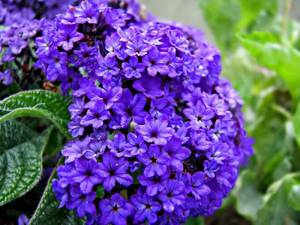
Heliotrope "Dwarf Marine"
“Sea Dwarf” variety It is characterized by the formation of attractive and very fragrant inflorescences consisting of bright blue flowers.
"Odysseus"
The variety "Odyssey" is a perennial plant grown as an annual. The variety is represented by a densely branching herbaceous bush with an above-ground part up to 25-30 cm high. Flowering is very abundant and long-lasting. The bush produces small and extremely fragrant flowers, collected in characteristic corymbose inflorescences. The highly decorative crop is used for landscaping balconies and loggias, is used in potted plants and in the design of carpet flower beds in personal plots.
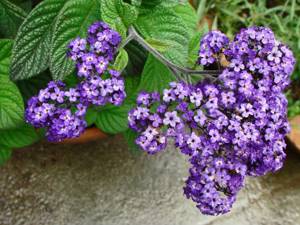
"Princess Marina"
The variety “Princess Marina” is a compact and relatively low plant, distinguished by flowers with an intense violet-blue color. The inflorescences are quite lush and highly decorative, characterized by a weak and unobtrusive aroma.
"White Lady"
The varietal feature of the heliotrope “White Lady” is a compact and low-growing, abundantly flowering crop. It is distinguished by buds of a pleasant soft pink color. At the stage of full dissolution, the flowers acquire a snow-white color.
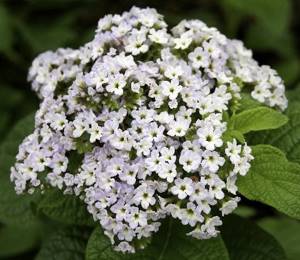
"Regal Dwarf"
Compact bush-like form, characterized by the formation of large and very fragrant flowers. Its short stature and decorative appeal have proven this variety excellent in indoor floriculture and in the design of garden flower beds.
Growing heliotrope from seeds
As a rule, approximately three to four months pass from germination to the phase of active mass flowering , so sowing work is recommended to be carried out from the last ten days of February to mid-March. It is best to prepare a nutrient mixture for growing based on non-acidic peat and medium-grained sand in a ratio of 4:1. You can also use regular store-bought flower soil.
Planting containers with drainage holes must be filled with moist, disinfected soil mixture. Sowing is done superficially or with a slight sprinkling of a nutrient mixture, which will prevent the risk of drying out. Crops must be covered with plastic film and installed in a room with a temperature regime of 18-20°C. After the mass emergence of seedlings, flower seedlings need to be provided with a sufficient amount of light and air temperature within 20-22°C. Diving into separate seedling pots is done after three or four leaves appear.
How to plant heliotrope for seedlings?
In order for the heliotrope flower to bloom in the garden in June, you need to sow its seeds in late February - early March. It is better to buy seed material in a specialized store, this will guarantee their good germination. Growing heliotrope from seeds occurs in the following sequence:
- Preparing the soil. You can buy it in the store or prepare a mixture consisting of 4 parts peat and 1 part sand. This composition must be steamed to avoid infection with fungal diseases.
- Pour the soil mixture into a small container, lightly moisten it and compact it.
- Scatter the seeds over the surface and sprinkle a little soil (this will help prevent them from drying out).
- Water the pot with the seeds, cover it with film and place it in a warm place with a maximum temperature of +20°C.
- After 5-20 days, the seeds should germinate. After the shoots emerge, remove the covering and transfer the container to a light windowsill.
- As soon as the seedlings have 2 true leaves, they need to be planted (planted) in separate pots and then watered.
- After 2 weeks, the grown plants can be fed with fertilizer for seedlings, for example, nitrophoska, kemira, fertika, dissolving 10-15 g of the product in 1 liter of water.
Planting technology
Before transplanting seedlings to a permanent place, it is necessary to provide the plants with hardening measures. Planting flower seedlings in open ground flower beds is carried out after the threat of damage to the ornamental crop by late return frosts has passed.
In the first weeks after planting, it is advisable to provide protection to young and immature plants using a frame-film cover. The planting scheme may vary depending on the species and varietal characteristics . Before planting, it is necessary to add high-quality humus to the planting hole, after which the root system of the plant is carefully placed and buried in soil. After compacting the soil, it is very important to water sufficiently abundantly with settled water.

Planting in flower beds
Before planting and caring for heliotrope in open ground, let’s find out when and how to plant it.
Heliotrope will delight owners even when planted directly in the garden, but flowering may not occur until August if the seeds are in the ground in May.
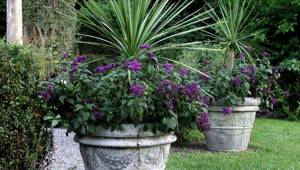
In the spring, the soil prepared in advance is loosened, phosphorus and potassium are added, then the seeds are thrown into the holes, buried half a centimeter. Afterwards watering is carried out.
Further care is exactly the same as for seedlings planted in boxes.
Selecting a location
Southern heliotrope prefers bright places exposed to the sun. The gardener receives this information when purchasing seeds - it is indicated on the bag, which is carefully studied before planting.

Before planting, the place where the flowers are supposed to be planted is dug up and humus, compost, and organic matter are added.
Cuttings
Cuttings are carried out by cutting off young shoots, which can take root either in the ground, covered with a film, or in a glass of water. After the roots grow, the heliotrope is planted in the garden.
Heliotrope: home care
When growing indoors, it is very important to follow a few simple recommendations:
- the crop needs to be provided with sufficient lighting while protecting the above-ground part from direct sunlight. It is considered optimal to place it on windowsills facing east and west;
- sufficient thermophilicity presupposes compliance with the temperature regime. In spring and summer, the temperature when visiting should be approximately 20-24°C. With the onset of autumn and winter, the temperature regime is no more than 16-18°C;
- Air humidity indicators require special attention. It is necessary to use regular spraying of the above-ground part with warm and settled water;
- With the beginning of active growing season and before flowering, the ornamental crop needs abundant and regular moistening of the earthen clod. Do not overdry or over-moisten the nutrient substrate in a flower pot. Water for irrigation must be soft and at room temperature;
- fertilizing is carried out from March until the end of the period of mass flowering. Complex mineral fertilizers are applied twice a month.
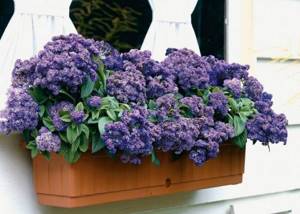
Indoor heliotrope needs to be replanted every year, around mid-March. The decorative perennial needs to be removed from the flower container, the damaged roots should be cut off and planted in a new flower pot that has a larger volume. A drainage layer must be poured onto the bottom of the planting container. After replanting, the above-ground part must be pinched.
A nutritious soil substrate based on four parts of turf substrate, a couple of parts of deciduous soil, a couple of parts of non-acidic peat and one part of coarse sand with the addition of a small amount of crushed charcoal and granular complex fertilizer is optimally suited for cultivation. Before replanting, the nutrient mixture must be disinfected in the oven.

Heliotrope care

Heliotrope is not picky, but it, like any garden plant, needs proper supervision:
- They require watering once every seven days. But if the waterlogging is very strong, the flower may die - it is attacked by mold, powdery mildew, and rot. Dry soil is also not a plant’s best friend. Watering is reduced only after flowering.
- The earth is constantly loosened, providing the roots with oxygen and mixing with fertilizers, providing the heliotrope with nutrients. Remove dried flowers and stems, directing the movement of juices to the living parts of the plant. Heliotrope needs to be provided with sufficient planting and care in open ground.
- At the beginning of the growing season, the green pet grows quickly, so it needs regular feeding with nitrogen-based fertilizers. Then phosphorus and potassium fertilizers are added to create luxurious baskets.
- To create a fuller bush, some branches can be removed or pinched, stimulating the formation of new shoots.

Features of outdoor care
To grow a profusely flowering and highly decorative plant, it is recommended to allocate areas well lit by the sun or with slight shading. The soil of the flower garden must be prepared in advance. The main feature of standard care for heliotrope of any type and variety is timely and moderate irrigation measures. To moisten the soil, it is advisable to use rainwater heated in the sun.
Immediately after irrigation activities, it is advisable to loosen the soil around ornamental plants a little. Such an event can be combined with the removal of weeds. Mulching the soil in flower beds gives very good results. For this purpose, you can use almost any organic matter, including sawdust and leaves and compost. To get the most abundant and long-lasting flowering, it is recommended to periodically pinch the stems.
Heliotrope: pinching (video)
The plant can be damaged by whiteflies, aphids or dangerous spider mites, to destroy which the aerial parts should be treated with a special modern preparation, Actellik. As a result of excessive irrigation measures and excessive accumulation of moisture in the soil near the root system, gray mold damage to ornamental crops can occur. At the first signs of fungal infection, fungicide treatment is performed.
All types of heliotropes are very impressive and are highly decorative. It is possible to get a new bush of this perennial crop yourself not only by sowing seed material, but also by cuttings. However, it must be remembered that only a limited number of varieties and hybrid forms are suitable for cultivation at home and in garden floriculture.
Plant diseases and pests
Like any other garden flower, litmus tincture can be affected by insects and infections:
| Disease/pest | Signs | Prevention/control measures |
| Spider mite |
|
|
| Aphid |
|
|
| Whitefly |
|
|
| Gray rot |
|
|

